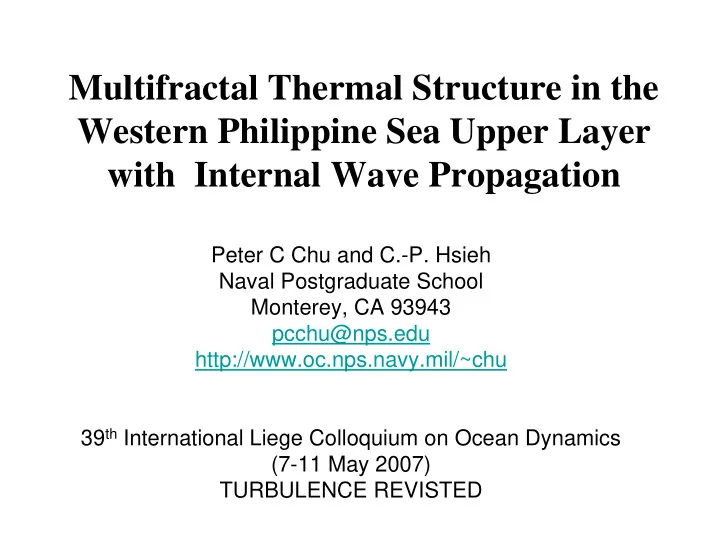

Multifractal Thermal Structure in the Western Philippine Sea Upper Layer with Internal Wave Propagation Peter C Chu and C.-P. Hsieh Naval Postgraduate School Monterey, CA 93943 pcchu@nps.edu http://www.oc.nps.navy.mil/~chu 39 th International Liege Colloquium on Ocean Dynamics (7-11 May 2007) TURBULENCE REVISTED
Upper Ocean Dynamics from http://www.hpl.umces.edu/ocean/sml_main.htm
What is the upper ocean thermal structure with internal wave propagation? An o bservational study in the western Philippine Sea is taken as an example for illustration.
Philippine Sea in World Oceans Philippine Sea in World Oceans
Geology and Topography East China Sea ASIAEX NAVO ASIAEX Philippine Sea South China Sea
Internal Waves and Solitons near Taiwan (Liu et al., 1998)
MODIS (bands 1,3,4) 250-m resolution visible image over the East China Sea August 3, 2003 at 0235 UTC (Alpers et al. 2004)
Internal Waves/Solitons in the South China Sea (Liu and Hsu, 2007) width ~ 0.8 km ESA 4/26/2000 RADARSAT 4/22/2000
Data Observation • Coastal Monitoring Buoy (CMB) - U.S. Naval Oceanographic Office - July 28 - August 7, 2005 - Ocean data 1,3,5,18, and 20 m Surface atmospheric data - Record intervals - 10 min • Thermistors - SBE 39 - Attached at 15 depths from 25 to 140 m. - Records intervals - 15 s.
Latitude - 22 ° 17´N - 23 ° 15´ N Latitude - 22 ° 17´N - 23 ° 15´ N • • Longitude - 124 ° 14´E - 124 ° 49´ E Longitude - 124 ° 14´E - 124 ° 49´ E • • • Distance - 229.14 Km • Distance - 229.14 Km • Velocity - 3.82m/ 15s • Velocity - 3.82m/ 15s
Taylor Hypothesis for Drifting Buoy Measurements • Difference between measurements at some time t and a later time t + acts as a proxy for the difference between measurements made at two points x and x + l . • T( t 1 ), T( t 2 ), …, T( t n ) … temporal interval • T( x 1 ), T( x 2 ), …, T( x n ), …spatial interval l
High-Order Structure Function Here, r is the lag, q is the order of the structure function. S ( r , 1) is the commonly used structure function . S(1,1) is the mean gradient .
Scale-Invariance H is the scaling exponent, or called the Hurst exponent. In 1941, Kolmogorov suggested that the velocity increment in high-Reynolds number turbulent flows should scale with the mean (time-averaged) energy dissipation and the separation length scale. The Hurst exponent H is equal to 1/3.
• Multifractal behavior • Simple self-similarity
Three Types (a) Internal Wave -turbulence (IW-T) (1000-1500 GMT July 29) (b) Internal Soliton - turbulence (IS-T) (0700-1200 GMT July 30) (c) Turbulence-dominated (T) (0000- 0500 GMT August 1)
Isopycnal Displacement (Desaubles and Gregg, 1981,JPO)
(a) IW-T type (1000-1500 GMT July 29) (b) IS-T type (0700-1200 GMT July 30) (c) T- type (0000- 0500 GMT August 1)
Isopycnal Displacement IW-T (10-15 GMT July 29)
Isopycnal Displacement IS-T (07-12 GMT July 30) Frequency is around 4 CPH
Isopycnal Displacement turbulence-Dominated (00-05 GMT Aug 1)
Power Spectrum Stationary Nonstationary with stationary increments Nonstationary with nonstationary increments
IW-T T IW-T and T have similar multi IS-T scaling characteristics with around 0.4 (stationary) for low wavenumbers and nearly 5/3 (non-stationary with stationary increment) for high wave numbers. 60 m depth
Structure Function (Power Law) IW-T type
Structure Function (Power Law) T type
Structure Function IS-T type Power law breaks at 8 min, near half period (4 CPH) of the internal solitons
Possible Reason for Preservation of the Power Law in IW-T Type Using the Hamitonian formulation, Lvov and Tabak (2001) modified the Garrett-Munk spectrum into which represents both internal waves and wave turbulence.
Possible Reason for Break of the Power Law in IS-T Type • The internal solitary waves are a class of nonsinusoidal, nonlinear, more-or-less isolated waves of complex shape that maintain their coherence. Their energy spectrum is totally different from the internal wave spectrum.
Conclusions • (1) Three types of thermal variability (IW-T, IS-T, and T) are identified. • (2) Multifractal structures are found in the upper layer of the western Philippine Sea. • (3) Power law preserves in structure function with multifractal characteristics for the IW-T and T types, but not for the IS-T type. • (4) The internal waves increase the power of the structure function especially for high moments. • (5) The internal solitons destroy the multifractal characteristics of the structure function at the lag of 8 min, which is nearly half period of the IS (with frequency of 4 CPH).
Recommend
More recommend